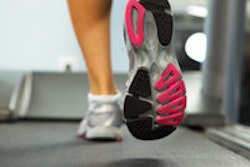Thanks to a lack of attention paid to developing comfortable and ergonomic work spaces, radiologists appear susceptible to work-related musculoskeletal symptoms, according to research presented Monday at the American Roentgen Ray Society (ARRS) meeting in San Diego.
Researchers from Massachusetts General Hospital (MGH) in Boston found that only 7.2% of surveyed radiologists did not have any work-related musculoskeletal symptoms. Investments in training and education seem required to address this health risk to radiologists, according to the study team.
"It's an important problem that affects every radiologist, regardless of your level of training, what specialty you're in, your location, and [whether you're in] academic or private practice," said Dr. Anand Prabhakar, a clinical fellow in abdominal imaging. "We need to do something about it before it becomes very debilitating to people."
Following anecdotal reports that many radiologists suffer from work-related musculoskeletal symptoms, the MGH research team sought to determine the prevalence of these symptoms in radiologists at a large tertiary-care hospital. They also wanted to investigate the effects of several workstation ergonomic factors and work habits on these symptoms, according to Prabhakar.
They administered a written questionnaire to 28 randomly selected radiologists (17 male, 11 female; age range = 36-50 years) from various divisions of a single radiology department. All of these radiologists primarily utilized PACS and speech recognition for interpretation, but also occasionally viewed hard-copy images, according to the researchers.
The questionnaire gathered information such as demographics, work-related musculoskeletal symptoms, work habits, and workstation design. Of the respondents, 50% had worked on the same system for longer than five years. In addition, 96% had two to three monitors at their workstation.
Only 7.2% were symptom-free, and 70% had seen a physician for work-related musculoskeletal symptoms. The researchers also found that 75% had changed their work schedule in response to symptoms.
Prevalence of musculoskeletal symptoms included:
- Neck pain in 42.8%
- Lower back pain in 39.2%
- Headache in 32.1%
- Shoulder pain in 32.1%
- Wrist pain in 7.4%
The MGH researchers also discovered that three radiologists (17%) never adjusted their chairs; all had three or more symptoms of musculoskeletal pain. Only 32.3% of respondents always adjust their chairs, while 42.8% said they sometimes did.
As for adjusting their monitors, 60.7% never did. Elbow rests were never used by 53.5% of respondents, of which 46% had shoulder pain. Only 50% had a regular exercise program.
However, the researchers did not find any relationship between those who had more adaptive responses overall and those who had fewer symptoms.
Prabhakar attributed the prevalence of musculoskeletal problems to a combination of factors, including the piecemeal approach of putting together radiology work spaces in the PACS era.
"For example, the PACS station is not purchased at the same time [from] the same vendor; it's not integrated with, say, the desk, telephone, mouse, keyboard, and dictation system," he told AuntMinnie.com. "There really has not been any interest in somebody putting it all together and really taking into account radiologist comfort."
Cost also can be a factor, Prabhakar said. Training and education are often not provided on how to set up work spaces to be more comfortable and ergonomic.
In another notable survey finding, radiologists expressed strong preferences for having more tools for combating repetitive stress injury, some of which are very low cost, he said. For example, approximately 70% of respondents thought a wireless mouse would be helpful and approximately 60% said a wireless keyboard would be helpful. And although it would be more expensive than a wireless keyboard or wireless mouse, more than 80% of respondents wanted a desk with an adjustable height.
"If we can somehow test whether those small things could help people, then I think it's a small investment in the long-term health of radiologists," he said. "I suspect, and I haven't proven it, that if radiologists are more comfortable, then they're going to work more efficiently. And that will increase productivity, which I think is the measure that administrators will look at before they invest in it."
As for specific steps radiologists can take to improve their work-space environment, Prabhakar suggests examining recommendations produced by the U.S. Department of Labor's Occupational Safety and Health Administration (OSHA). Those guidelines, which are available online as an e-tool, provide a range of tips for creating safe and comfortable workstations.
"Ultimately, I hope that this project inspires other people to take control of their own workspace, maybe inspire industry or academic institutions to address the problem, and hopefully future research will prove that this may improve our productivity," he said.
Future research efforts will evaluate the impact of training and education on the symptoms of work-related musculoskeletal symptoms, Prabhakar said.
By Erik L. Ridley
AuntMinnie.com staff writer
May 3, 2010
Related Reading
Ergonomic practices can decrease repetitive stress injuries, May 18, 2009
Wii remote, Baroque music can lighten the load in reading rooms, April 28, 2009
Lean management plays key role in new hospital design, March 8, 2009
PACS software tool boosts clinical follow-up, December 15, 2008
PACS comes with risk of repetitive stress injuries, September 8, 2008
Copyright © 2010 AuntMinnie.com




















